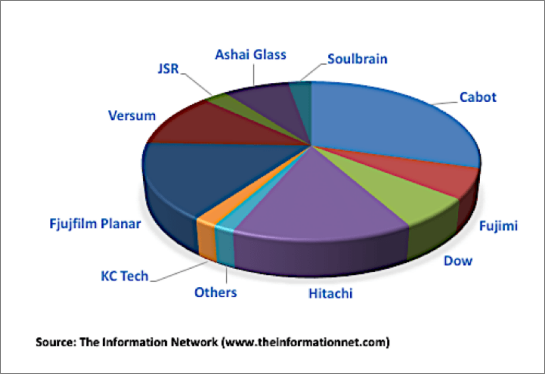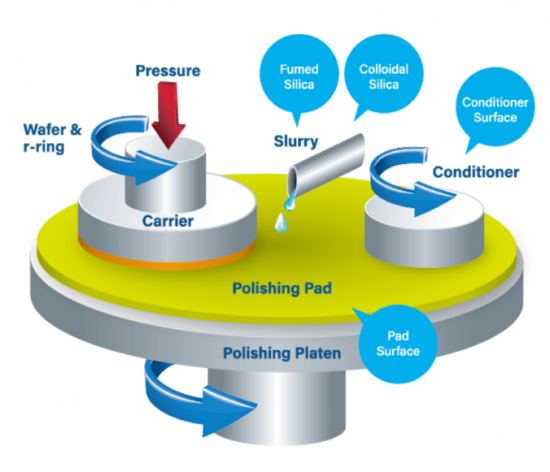 |
市場調查報告書
商品編碼
1473283
CMP設備及耗材:市場分析與預測CMP Equipment and Consumables: Market Analysis and Forecasts |
||||||
促進者
化學機械平坦化 (CMP) 市場涵蓋設備和漿料領域,在半導體產業需求不斷增長的推動下,目前正經歷一個動態成長和創新的時期。隨著奈米製程尺寸的進步和每個晶片功能的增加,半導體元件的複雜性不斷增加,CMP 在製造過程中的作用從未如此重要。這種精確的材料去除製程對於確保連續光刻和蝕刻步驟之間的晶圓表面平整度至關重要,並且隨著裝置變得越來越小,課題變得越來越嚴峻。

CMP 設備市場正在見證旨在提高平坦化製程的效率、準確性和一致性的重大技術進步。製造商正專注於開發能夠處理更大晶圓的設備,並滿足微調材料去除率的需求。這包括增強拋光墊調節技術、拋光頭和載體技術,以及整合更複雜的端點檢測系統以防止過度拋光。此外,還非常重視自動化和軟體集成,CMP 設備現在配備了先進的監控和調整功能,以最大程度地減少人為錯誤並即時適應不斷變化的製程條件。
同時,CMP 漿料市場隨著設備的進步而不斷發展,以滿足先進半導體裝置中新材料和複雜結構的嚴格要求。漿料配方變得更加多樣化和專業化,以滿足特定的材料去除需求,例如銅、鎢和介電材料。

漿料的開發需要磨料顆粒尺寸、濃度和化學添加劑之間的微妙平衡,以實現所需的去除率和表面光潔度,同時最大限度地減少缺陷的發生。環境考量也是重中之重,推動了環境友善漿料組合物的開發,以減少浪費並且對工人來說更安全。
市場成長是由消費性電子產品、高效能電腦平台和資料儲存解決方案快速成長的需求所推動的,所有這些都需要先進的半導體晶片。此外,汽車產業越來越依賴電動車和駕駛輔助系統的電子元件,促進了 CMP 市場的擴張。5G 技術和物聯網的興起將進一步加速對半導體的需求,間接推動對更有效率、更高吞吐量的 CMP 製程的需求。
然而,CMP 市場面臨著設備和材料成本高昂、需要持續創新以跟上半導體進步步伐以及管理複雜的供應鏈等課題。半導體產業的全球性也使 CMP 市場面臨地緣政治緊張局勢和貿易爭端的影響,這可能會影響材料採購、製造和銷售。
綜上所述,CMP設備及漿料市場正處於關鍵時刻,機會與課題並存。隨著半導體產業不斷課題技術極限,CMP 在製造先進裝置中的重要性不斷增長。適應市場快速技術變化的能力以及設備和耗材的創新能力將是滿足未來半導體製造流程需求的關鍵因素。
關於本報告
本報告分析了全球 CMP 設備和耗材市場,提供了技術概述、市場基本結構、CMP 設備和耗材的主要類型和特點、用戶需求以及整體市場規模趨勢。
目錄
第一章簡介
第二章執行摘要
- 介紹
- 市場機會
第三章 展平方法
- 平整度的必要性
- 光刻
- 氣相沉積
- 蝕刻
- 應用領域
- 電介質
- 金屬
- 平整技術
- 局部扁平化
- 整體扁平化
- 化學機械拋光
- 背景狀況
- 研究工作
- 優點和缺點
- 加工參數
- 設備加工參數
第四章 CMP耗材
- 泥
- 類型
- pH值的影響
- 氧化劑
- 顆粒形態的影響
- 化學品配送管理
- 漿料供應商簡介
- 磨料供應商
- CMP後清洗
- 拋光墊
- 類型
- 表現
- 無漿墊
第五章 CMP設備
- 單頭方法
- 優勢
- 壞處
- 多頭方法
- 設備簡介
- Applied Materials
- Ebara
- Strasbaugh
- Novellus
- Nikon
- Doosan Mecatec
- 其他參與企業
- 集群工具
- 競爭性非 CMP 工具
第六章 使用者問題
- 擁有成本
- 用戶要求
- 供應商基準
- 價格
- 供應商的承諾和態度
- 供應商能力
- 系統特點
- 用戶和供應商之間的協同
- 設備評估期間的回饋
- 設備製造過程中的回饋
- 可靠性
- 設備可維護性
第七章 市場預測
- 介紹
- 市場預測的先決條件
- 設備市場
- 介紹
- CMP拋光機市場
- 消耗品市場
- 泥
- 軟墊
Driving Forces
The Chemical Mechanical Planarization (CMP) market, encompassing both the equipment and slurry sectors, is currently experiencing a dynamic period of growth and innovation, driven by the escalating demands of the semiconductor industry. As the complexity of semiconductor devices continues to increase, with the push towards smaller nanometer processes and the integration of more functions per chip, the role of CMP in the manufacturing process has become more critical than ever. This precision material removal process is essential for ensuring the planarity of wafer surfaces between successive lithography and etching steps, a requirement that becomes increasingly challenging as device geometries shrink.

The CMP equipment market is witnessing significant technological advancements aimed at improving the efficiency, accuracy, and consistency of the planarization process. Manufacturers are focusing on developing equipment that can accommodate the increasing size of wafers and the need for finer control over material removal rates. This includes enhancements in pad conditioning techniques, head and carrier technologies, and the integration of more sophisticated endpoint detection systems to prevent over-polishing. The emphasis on automation and software integration is also prominent, with CMP equipment increasingly featuring advanced monitoring and adjustment capabilities to minimize human error and adapt to varying process conditions in real time.
Simultaneously, the CMP slurry market is evolving in tandem with equipment advancements to meet the stringent requirements of new materials and complex structures found in advanced semiconductor devices. Slurry formulations are becoming more diverse and specialized, tailored to specific material removal needs, such as copper, tungsten, or dielectric materials.

The development of slurry involves a delicate balance between abrasive particle size, concentration, and chemical additives to achieve the desired removal rate and surface finish, while minimizing defectivity. Environmental considerations are also coming to the forefront, with a push towards developing more eco-friendly slurry compositions that reduce waste and are safer for workers.
Market growth is being fueled by the burgeoning demand for consumer electronics, highperformance computing platforms, and data storage solutions, all of which require advanced semiconductor chips. Additionally, the automotive sector's increasing reliance on electronic components for electric vehicles and driver assistance systems is contributing to the expansion of the CMP market. The rise of 5G technology and the Internet of Things (IoT) further compounds the demand for semiconductors, indirectly driving the need for more efficient and capable CMP processes.
However, the CMP market faces challenges, including the high cost of equipment and materials, the need for continual innovation to keep pace with semiconductor evolution, and the management of supply chain complexities. The global nature of the semiconductor industry also exposes the CMP market to geopolitical tensions and trade disputes, which can impact material sourcing, manufacturing, and sales.
In conclusion, the CMP equipment and slurry market is at a critical juncture, with opportunities and challenges in equal measure. As the semiconductor industry continues to push the boundaries of technology, the importance of CMP in manufacturing advanced devices will only grow. The market's ability to adapt to rapid technological changes, along with its capacity to innovate in both equipment and consumables, will be key factors in meeting the future demands of the semiconductor manufacturing process.
About This Report
This 225-page report provides an overview of the current market size and growth trajectory for CMP equipment and slurry markets. Include historical data, forecasts, and factors driving market expansion or contraction.
It discusses the latest trends shaping the CMP equipment and slurry markets, such as advancements in semiconductor technology, materials diversity, environmental sustainability, automation, and global market expansion.
Key Players operating in the CMP equipment and slurry markets and analyzed and forecast, along with their market share, key product offerings, and competitive strategies. Slurry markets are analyzed by slurry type and slurry supplier:
Oxide slurry
- ILD Slurry
- STI Slurry,
W Slurry
Copper slurry
- Cu Barrier Slurry
- Cu Slurry Step 1
This report identifies key challenges facing the CMP equipment and slurry markets, such as rising production costs, technological barriers, geopolitical tensions, and competitive pressures. It provides insights into the future outlook for CMP equipment and slurry markets, including anticipated growth opportunities, emerging technologies, potential disruptors, and strategic recommendations for stakeholders.
Table of Contents
Chapter 1. Introduction
Chapter 2. Executive Summary
- 2.1. Introduction
- 2.2. Market Opportunities
Chapter 3. Planarization Methods
- 3.1. Need for Planarity
- 3.1.1. Lithography
- 3.1.2. Deposition
- 3.1.3. Etching
- 3.2. Applications
- 3.2.1. Dielectrics
- 3.2.2. Metals
- 3.3. Planarization Techniques
- 3.3.1. Local Planarization
- 3.3.1.1. Deposition-Etchback
- 3.3.1.2. ECR
- 3.3.1.3. Oxide Reflow
- 3.3.1.4. Spin-on-Glass
- 3.3.1.5. TEOS-Ozone
- 3.3.1.6. Laser
- 3.3.2. Global Planarization
- 3.3.2.1. Spin-On Polymer
- 3.3.2.2. Polyimide Coating
- 3.3.2.3. Isotropic Etch
- 3.3.2.4. Spin Etch Planarization
- 3.3.2.5. Electropolishing
- 3.3.1. Local Planarization
- 3.4. CMP
- 3.4.1. Background
- 3.4.2. Research Efforts
- 3.4.3. Advantages and Disadvantages
- 3.4.4. Process Parameters
- 3.4.4.1. STI Planarization
- 3.4.4.2. Copper CMP
- 3.4.4.3. Low-K Integration
- 3.4.4.4. Defect Density
- 3.4.4.5. Metrology
- 3.4.5. Device Processing Parameters
- 3.4.5.1. Memory Devices
- 3.4.5.2. Logic Devices
Chapter 4. CMP Consumables
- 4.1. Slurries
- 4.1.1. Types
- 4.1.2. pH Effects
- 4.1.3. Oxidizers
- 4.1.4. Particle Morphology Effects
- 4.1.5. Chemical Distribution Management
- 4.1.6. Slurry Supplier Profiles
- 4.1.7. Abrasive Suppliers
- 4.2. Post-CMP Clean
- 4.3. Polishing Pads
- 4.3.1. Types
- 4.3.2. Performance
- 4.3.3. Slurryless Pads
Chapter 5. CMP Equipment
- 5.1. Single-Head Approach
- 5.1.1. Advantages
- 5.1.2. Disadvantages
- 5.2. Multi-Head Approach
- 5.2.1. Advantages
- 5.2.2. Disadvantages
- 5.3. Equipment Profiles
- 5.3.1. Applied Materials
- 5.3.2. Ebara
- 5.3.3. Strasbaugh
- 5.3.4. Novellus
- 5.3.5. Nikon
- 5.3.6. Doosan Mecatec
- 5.3.7. Other Entrants
- 5.4. Clustered Tools
- 5.5. Competitive Non-CMP Tools
Chapter 6. User Issues
- 6.1. Cost of Ownership
- 6.2. User Requirements
- 6.3. Benchmarking a Vendor
- 6.3.1. Pricing
- 6.3.2. Vendor Commitment and Attitudes
- 6.3.3. Vendor Capabilities
- 6.3.4. System Capabilities
- 6.4. User-Supplier Synergy
- 6.4.1. Feedback During Equipment Evaluation
- 6.4.2. Feedback During Device Production
- 6.5. Reliability
- 6.6. Equipment Maintainability
Chapter 7. Market Forecast
- 7.1. Introduction
- 7.2. Market Forecast Assumptions
- 7.3. Equipment Market
- 7.3.1. Introduction
- 7.3.2. CMP Polisher Market
- 7.4. Consumable Market
- 7.4.1. Slurry
- 7.4.2. Pads
List of Figures
- 1.1. Process Integration for CMP
- 3.1. Levels of Integration of Dynamic Rams
- 3.2. Planarization Lengths of Various Methods
- 3.3. Normalized Removal Rates
- 3.4. Reduced Complexity With Copper
- 3.5. Copper Loss From CMP
- 3.6. CMP Copper Process Technologies
- 3.7. CMP Performance Improvements
- 3.8. Polish Endpoint Control
- 4.1. Effect of Nitrate Ions on the Cu Removal Rate
- 4.2. Removal Rate of Ta
- 4.3. Bulk Chemical Distribution System
- 4.4. Through The Brush Chemical Delivery
- 4.5. Megasonics Post-CMP Clean
- 4.6. Micrograph Of 3M Slurryless Pad
- 6.1. Effect of Tool MTBF on CMP Cost
- 6.2. Removal Rate Vs Throughput and CMP Cost
- 7.1. Worldwide CMP Polisher Market
- 7.2. Worldwide CMP Slurry Market Forecast
- 7.3. CMP Slurry Market by Application
- 7.4. ILD Slurry Market Share
- 7.5. STI Slurry Market Share
- 7.6. Copper Barrier Slurry Market Share
- 7.7. Copper Step 1 Slurry Market Share
- 7.8. Worldwide CMP Pad Market Forecast
- 7.9. CMP PAD Market Shares
List of Tables
- 3.1. Interconnect Levels of Logic Device
- 3.2. Typical Process Specifications
- 3.3. Organic Polymers for IMD Applications
- 3.4. CMP Process Variables
- 3.5. Optimized CMP and Post-CMP Clean Parameters
- 3.6. Interconnect Materials by Segment
- 4.1. CMP Slurry Suppliers
- 4.2. Abrasive Suppliers and Products
- 4.2. Oxide CMP Pad Properties and Performance
- 6.1. Polisher Equipment Targets
- 6.2. Post-CMP Clean Equipment Targets
- 7.1. Worldwide CMP Polisher Market Forecast
- 7.2. Worldwide CMP Polisher Market Shares
- 7.3. Worldwide CMP Slurry Market Forecast
- 7.4. Worldwide Slurry Market Shares
- 7.5. Worldwide CMP Pad Market Forecast










